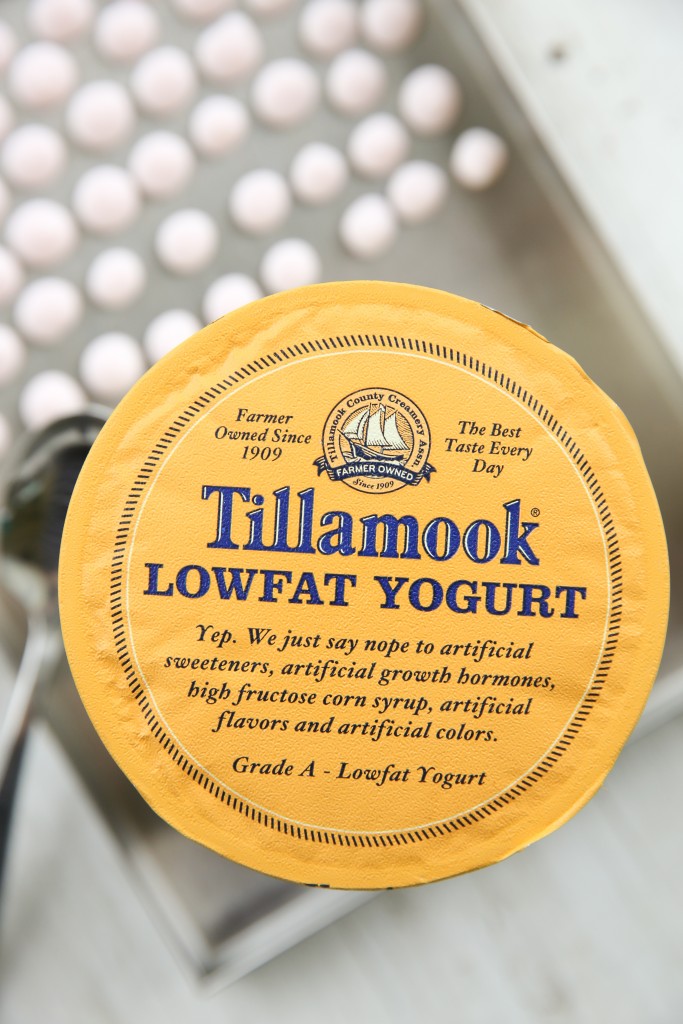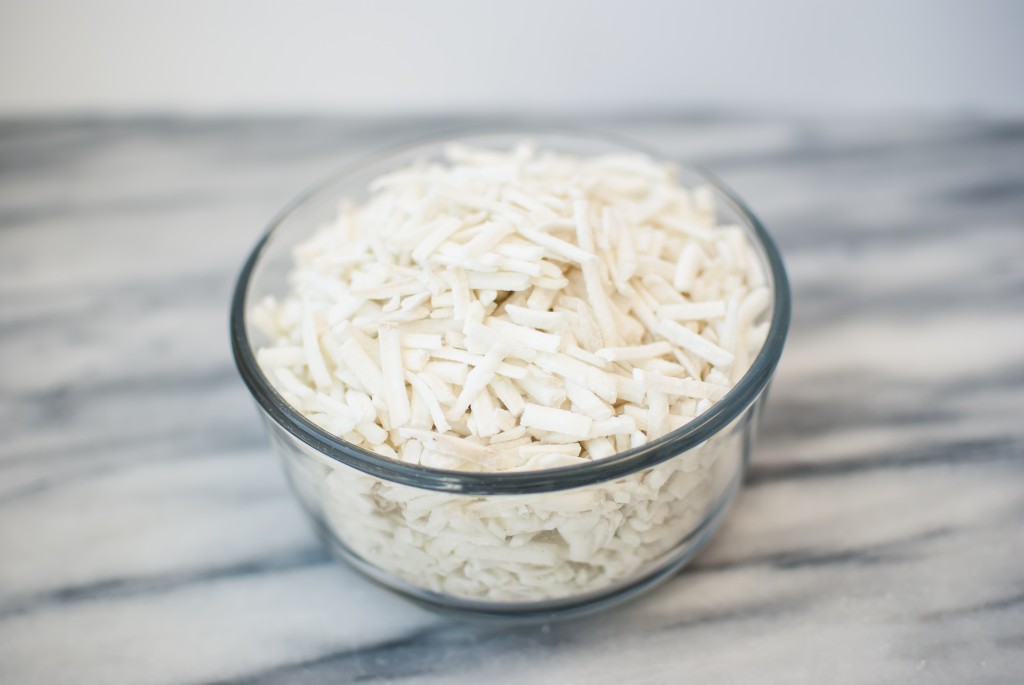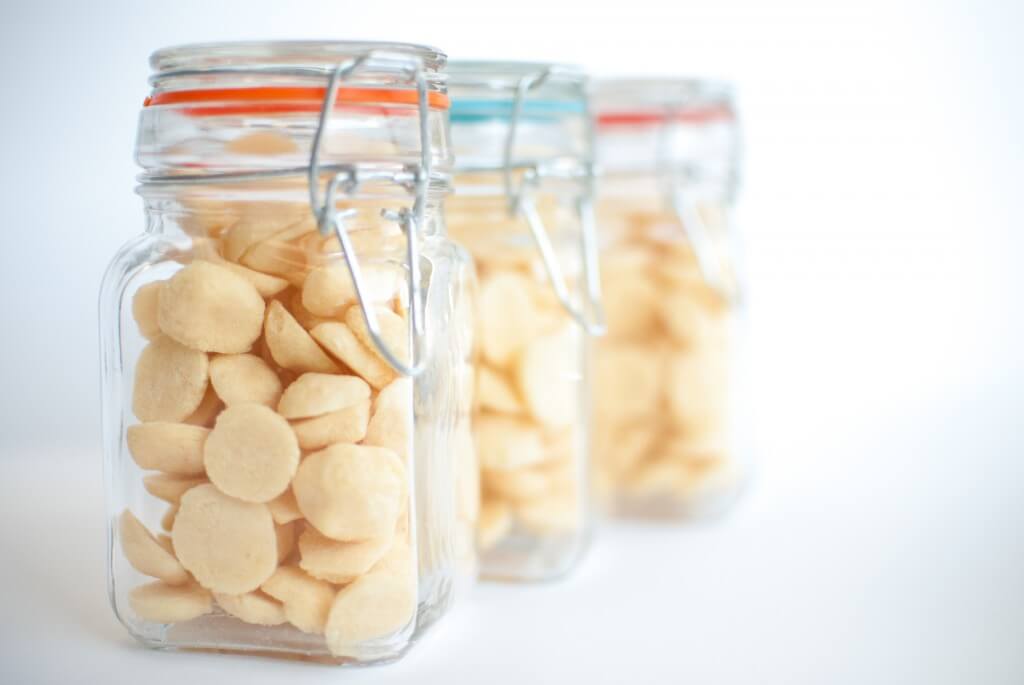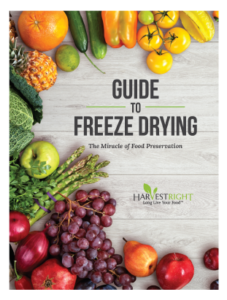
Freeze-dried dairy products are some of the most versatile ingredients you can have in your pantry. Dairy is not only easy to freeze dry, it’s easy to rehydrate and use in recipes. For example, yogurt is high in protein, so adding it to your breakfast oatmeal adds to the nutritional content. Yogurt drops are a big favorite among our customers, and if you haven’t yet had freeze dried ice cream you need to go do that right now.

To freeze dry dairy products such as sour cream or yogurt, spread a thick, even layer on a freeze drying tray. You can also freeze dry milk – when ground to a powder it makes recipes such as cakes extremely moist. When you’re ready to rehydrate freeze dried dairy, just add water gradually and stir until it returns to its original state. If you’re freeze drying ice cream sandwiches, no need to rehydrate. Just eat them as a crunchy snack. Or, powder them up in a food processor and add them to another recipe to get a delicious ice cream flavor.

Sliced and grated cheese can also be freeze dried. To rehydrate, you can easily toss it on top of your casserole dish, cover with tin foil and it will rehydrate from the moisture in the other food. Or, you can spritz it with a little water or even add water to it and warm it up in the microwave to get melted cheese. If you want to rehydrate sliced cheese, put it in a ziplock bag with moist towel until it returns to its original consistency. Freeze dried cheese is delicious on its own, but it’s wonderful to have on hand for pastas and casseroles.

To freeze dry raw eggs, whisk them before pouring onto a freeze drying tray. Freeze dried eggs will powder really easily and to rehydrate, just add water. You can also make delicious scrambled eggs and freeze dry them. Try adding cheese or bits of ham and you can easily reconstitute later with a little water in the microwave or in a skillet on the stovetop.
Dairy products have a short shelf life in your refrigerator – but if you have a home freeze dryer, you’ll not only reduce food waste, you’ll increase the versatile ingredients in your long-term food storage.





Can you freeze dry milk and if so how well does milk freeze dry?
Yes! Milk freeze dries great. It turns into a true milk powder that can then be easily rehydrated.
If powered milk is already in a dry state how and why would you freeze dry it?
Cam you freeze dry heavy whipping cream?
No, the fat content is too high and it turned into butter when we did it. Really nice hard butter; but not a storable powder.
I had great success with heavy whipping cream. I did not have the result that Stephen had.
I do. I’ve had mine last minimum of 1 yr but I used it up. I’ve starting trials of how long it lasts before going rancid.
Freeze dried heavy cream powders are available from Judee’s, Anthony’s, and Hoosier Hills Farms, etc. If they can freeze dry heavy cream, then so can you. It may require a bit of “technique”, but it it is certainly possible. I’ve heard diluting fatty/oily liquids with more water can help, or maybe they whip it, then freeze it, and THEN freeze dry. Experiment and see what works for you.
You freeze dry “liquid” milk to make milk powder.
Can you freeze dry a full fat heavy cream? Will it rehydrate creamy and smooth, or like broken fat lumps? Finally, if properly stored with oxygen absorbers, what’s the shelf life of pure freeze dried heavy cream? Thanks!
Waiting on a response to this question as well.
Can You Freeze Dry Heavy(Full-Fat) Cream……?
Heavy cream is a short-term storage freeze-dried food. The oil/fat content is so high it tends to have a oily feel to it once freeze dried and is not something that would work for long-term storage.
you may want to try heavy coconut cream….either canned or dried…..it does reconsitute…..I have successfully freezedried coconut heavy cream….you can whip it, and the mouth feel is just like heavy dairy whipped….however, when the dairy cream is already cooked in products…such as an Indian mango pudding….you can then freezedry this and it is super dry and I expect will be a longer term store item…..really yummy…love my HR FD
Can we freeze dry raw milk?
I have before.
What is the ratio of water to powder to rehydrate milk?
1 to 1 ratio of water to powder.
Is that by volume or by weight?
That’s my question too. did you get a reply?
I use one cup of milk powder to make one quart . To prevent clumping, I use a two quart pitcher, add about an inch of water to pitcher then add two cups of powdered milk then slowly add water while stirring until pitcher is full then chill in fridge. Tastes exactly like store bought milk.
1:1 ratio
3 Tbsp powered milk + 1 cup water = 1 cup of milk
Can you freeze dry buttermilk?
Yes, you can freeze dry buttermilk!
Thank you! What about heavy whipping cream?
Heavy cream is a short-term storage freeze-dried food. The oil/fat content is so high it tends to have a oily feel to it once freeze dried and is not something that would work for long-term storage.
How long is short term? I freeze dried heavy whipping cream and put it in the freezer but if I lost power how long do you think it could be on the shelf in a Mylar bag with o2 absorber?
I have been watching FD Videos on Freeze Drying Heavy Cream. I understand that it won’t reconstrue very well back into Heavy Cream, but that’s alright, I’m looking to Freeze Dry Heavy Cream and then reconstitute it and make fresh Butter out of it. I have seen this done on Videos (usually by mistake. LOL!) But I would like to FD a Large Quantity of Heavy Cream for this purpose. I see that HR recommends storing FD Heavy Cream for only “Short-Term storage” but considering most FD Items can be stored for 20-25 YEARS. I would REALLY like a more precise time frame for how long powdered FD Heavy Cream could be stored for. (3-5 years?…) Has Anyone FD Heavy Cream a while ago and could give us their experience?
do the Freeze Dryers come with instruction booklets for freeze drying times and reconstitution instructions?
Yes, you get an Owner’s Manual and a Starter Guide with your freeze dryer purchase, which gives you some instructions as to how to begin freeze drying. There are also a lot of online resources that can help determine a good range of what to expect for different foods. It’s hard to give one specific dry time/reconstitution method for every single food because there are many variables that can impact it – there is not typically just one clear-cut answer. But, for example, the default dry times that are built right into the freeze dryer work for most foods. Just check the food at the end of each batch to test its dryness then decide if you are ready to defrost the freeze dryer or if you need to add more dry time. You will see that a lot of the learning happens naturally as you start using your freeze dryer.
Should I expect to waste some food during the learning process?
If I only use my freeze dryer once a week, would I ever need to defrost it?
I would not expect to waste any food at all. The freeze dryers are very easy to use. If you use it once a week you will never need to defrost. The defrost is only needed for back to back batches.
I freeze dried potato salad. The potatoes were dry and crisp as they should be. However the remainder was an oily globby mess. So do not freeze dry heavy cream. Too much oil. Nothing with lots of fat and oil will work well.
Can we freeze/dry kefir? Kefir is like a yogurt drink, e.g. thick like buttermilk.
Yes, I’ve seen where a lot of people have done it successfully.
Do the probiotics become viable again after rehydration?
Yes. The probiotics survive the freezing process.
does 1 gallon of milk freeze dried make alot less reconstituted milk? the powder produced seems less than a gallon of milk.
No, the ratios stay the same. If you freeze dry a quart of milk, just reconstitute to a quart size. It’s easy if you store the freeze dried milk in, say, a quart size jar. Then just add water to fill the quart.
Can you over freeze dry
The general consensus I have read is not really. Theoretically you could have the heating trays too warm and if left In too long It could impact the product by possibly “burning” it. But that is not the freeze drying per we but over heating the food.
Should I vacuum seal my jars of freeze dried milk or will it store fine with just a lid and not sealed?
For longer storage than a few weeks you will definitely want to take the oxygen out. Vacuum sealed with an o2 absorber is best.
Can you freeze dry rice milk???
I have never tried it but it should not be a problem at all since rice freeze dries wonderfully.
I have a freeze dryer and love it. I have dried lots of raw eggs. I have looked and looked for how much water to add to my 2 Tablespoons of egg to make 1 egg. No answer to be found. They all say just add water. I know that HOW MUCH WATER though?? Please help me, sometimes I would like to add an egg to a recipe I can’t leave to liquid the same though
1 Tbs egg to 1 Tbs water makes 1 egg is what I had found
2 Tbsp dried egg + 2 Tbsp Water = 1 Egg
Answer found in Video on Harvest Right Web site-
Great to watch all of them while you are awaiting your new Freeze Drier. I can’t hardly wait on mine to come in! I think I can start using it right away, I’ve memorized everything so far to get started…
I saw your post on Harvest Right. You were waiting on delivery of your freeze dryer.
I’m curious about your opinion 7+ months later.
Thanks!
2 Tbsp dried egg to 2 Tbsp water = 1 whole egg
Do you have a scale at home? You could try weighing your tray with the fresh eggs on it, and write down the number of eggs you have on the tray. Then, dry the tray, and weigh the tray when it is done, before you take off the dried eggs. Then subtract the weight of the fresh eggs from the weight of the dried eggs, and divide that weight by the total number of eggs you had on the tray. This will be the weight of water that was originally in each egg that was lost. You should be able to add that amount of water to each egg to reconstitute it. Water is 1 g per mL at room temperature. Then you can use 1 Tbs of water = 15 grams of water to convert to tablespoons of water to add per egg. I hope this helps.
We have found that a 1 to 1.5 ratio is perfect for us. So for 1 Tablespoon egg powder we add 1.5 Tablespoon water. You can experiment with it.
I did exactly as Shelly suggests above and found the following ratio for one large egg:
*1 TBSP + 1 tsp firmly packed egg powder
*2 TBSP + 1 tsp water
Yield: one whole egg.
Any of the suggested ratios work when simply making scrambled eggs. But, when using freeze dried eggs in recipes where achieving the correct moisture content is important, I use the above ratio.
I am embarking on a 5 week backpacking trip pretty soon and I want to freeze dry 1/2 and 1/2 to use in my coffee in the morning – does anyone have any feedback on this? Planning to just add a spoonful to my instant coffee and be good to go – thoughts?
Half and half freeze dries well but is higher in fat that milk so it tends to be oily. If you just drop the freeze-dried disk of half and half in your coffee, it will be oily and not quite what you expect. Most customers say it works better to rehydrate and blend it first with some water (even refrigerating overnight) and then adding that to your coffee.
I found the best was to make my coffee the way I like it then freeze dry it. Instant coffee just the way I like it.
Rather than dropping a full disc of half and half in your coffee you might also try blending it into a powder and adding spoonfuls. In this way you get a powdered creamer experience but with actual half and half. It sounds like this was your initial thoughts, and it should work fine.
I have a large FD. I recently FD 1/2 gal of milk on each tray (5) for 2 1/2 gal total. I had no issues, everything went well. However, I was told after I did it by a more experiences user to only FD 1 qt per tray because doing more could damage the pump (water vapor getting into it) and shorten the pumps life. Is this true?
If so, what is the maximum amount of liquid for a large Harvest Right Freeze dryer. TIA
What you did is not a problem. It is good to watch the oil though and make sure it stays clean.
whole raw milk has a quantity of cream, how well does this freeze dry – shelf life? Is the texture and taste of the raw milk altered upon rehydration?
If I freeze dried cheese cake , am I able to get it back to its original form or just need to eat it as it is when freeze dried?
Most like to snack in its freeze dried state, but I have seen some add water and put in a ziplock bag over night with good success.
I very recently watched a video where some Homesteaders had a harvest freeze dryer and tried to freeze dry their cows cream. In the video the cream completely bubbled over into an all over the inside of the freeze dryer. Why did this happen? Thank you for your time
When freeze drying liquids we recommend pre-freezing the products in a regular freezer. This customer did not do that.
What is the consistency like on a rehydrated cheese?
If you freeze dry kefir as previously asked, or a probiotic yogurt, does the process kill the beneficial bacteria content…same question with kombucha…??
Maybe this article will help: https://harvestright.com/blog/2019/merging-food-preservation-techniques-fermentation-and-freeze-drying/
If you turn the temperature of the drying process down to like 140F , the bacteria should not be harmed. However, the typically drying temperature is in the 150s, which is probably hot enough to kill the probiotics.
Can you freeze dry almond milk?
I just freeze drying the 80cal. Almond milk I purchased. It took forever to freeze dry – about 57 hours. I will try again making the 30 cal. Almond milk, if that does not work better – which I think it will, I will try grinding almonds and making from scratch. I am thinking it’s the added sugars that made it “sticky” .
Is it safe to freeze dry breast milk
Would Love an answer to that question also. Not only if it is possible to FD Breast Milk, but also is it safe, does it maintain its nutrients and how to best reconstitute it? Anyone’s experience with this topic would be greatly appreciated!
Do you know if the “live” cultures in yogurt remain live, during freeze drying and reconstituting or is the benefit to freeze drying yogurt just the protein source?
How many cups of freeze dried milk makes up a gallons worth?
Scott, I freeze dry whole white milk. The volume of milk going in is 1 gallon total (1 quart per tray). I weight the freeze dried milk when completed and calculate reconstitution amounts based on weight.
I consistently need 30 grams of FD milk to make 1 Cup of milk.
I use weight because the dried milk product volume can vary dramatically depending on whether I make a fine powder in the blender (smallest volume) or just crush it by hand (larger volume, but faster for me to package).
Your preference for the final product may vary, so experiment with different ratios until you get a suitable product.
We freeze dried 2% milk. When we rehydrated it, it has that weird taste like the freeze dried milk you buy in the store . Very disappointing since everyone says it tastes like fresh milk.
If I have 1 cup of non compacted freeze dried raw milk, how much water do I need to add?
I’ve decided to take the guess work out of it and put 1 qt of milk per tray (using a canning jar) and then I can package accordingly. Then, when I need it, I can put the package back into the canning jar and add water to neck (or wherever I poured to before drying) and KNOW that’s the water I need. I’m never going to need less than a quart for my needs before it would spoil.
I’ve discovered through the internet and from a ‘food scientist’ that if you’re going to freeze dry eggs, you need to add salt to the eggs before freezing. This keeps the protein molecules from breaking down during freezing so the rehydration process produces eggs the same consistency of fresh. you can also add sugar or, I forgot the other one, but neither seem palatable for eggs to me.